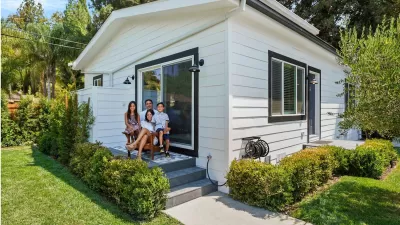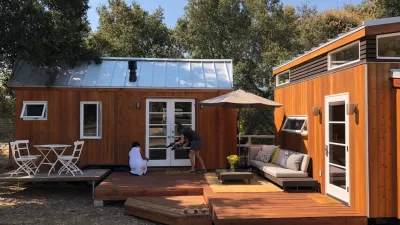Although state-level laws are making it easier for homeowners to build accessory dwelling units, high impact and development fees remain a major barrier for many prospective ADU builders.

While many states are liberalizing regulations related to accessory dwelling units (ADUs) to make ‘granny flats’ easier to build, “local governments remain the key gatekeepers when it comes to ADU liberalization,” writes Mike Koenig in HousingWire.
For Koenig, there’s still work to do to ensure property owners around the country can easily and affordably build backyard cottages or other add-on units on residential lots that can help gently increase density and improve housing affordability.
“As state legislatures continue to press municipalities to ease or remove ADU-related restrictions (13 and counting have done so), utility and other fees—collectively known as impact fees—move toward the center of pro-ADU policy discussions. That’s because impact fees can add up to more than enough to stifle ADU development.” Koenig recommends a few ways cities can ensure their regulations aren’t limiting ADU production, including prorating impact fees and waiving certain development fees.
Koenig points out that the higher density created by ADUs can bring long-term benefits to the community beyond housing affordability, including higher tax revenues. But while costs and other barriers remain high, “States and municipalities have come a long way in smoothing the paths forward for those who hope to add vital infill housing through ADUs.”
FULL STORY: Opinion: States are making ADUs easier to build. Now it’s up to municipalities to follow suit.

Trump Administration Could Effectively End Housing Voucher Program
Federal officials are eyeing major cuts to the Section 8 program that helps millions of low-income households pay rent.

Planetizen Federal Action Tracker
A weekly monitor of how Trump’s orders and actions are impacting planners and planning in America.

Ken Jennings Launches Transit Web Series
The Jeopardy champ wants you to ride public transit.

Crime Continues to Drop on Philly, San Francisco Transit Systems
SEPTA and BART both saw significant declines in violent crime in the first quarter of 2025.

How South LA Green Spaces Power Community Health and Hope
Green spaces like South L.A. Wetlands Park are helping South Los Angeles residents promote healthy lifestyles, build community, and advocate for improvements that reflect local needs in historically underserved neighborhoods.

Sacramento Plans ‘Quick-Build’ Road Safety Projects
The city wants to accelerate small-scale safety improvements that use low-cost equipment to make an impact at dangerous intersections.
Urban Design for Planners 1: Software Tools
This six-course series explores essential urban design concepts using open source software and equips planners with the tools they need to participate fully in the urban design process.
Planning for Universal Design
Learn the tools for implementing Universal Design in planning regulations.
Heyer Gruel & Associates PA
Ada County Highway District
Institute for Housing and Urban Development Studies (IHS)
City of Grandview
Harvard GSD Executive Education
Toledo-Lucas County Plan Commissions
Salt Lake City
NYU Wagner Graduate School of Public Service





























